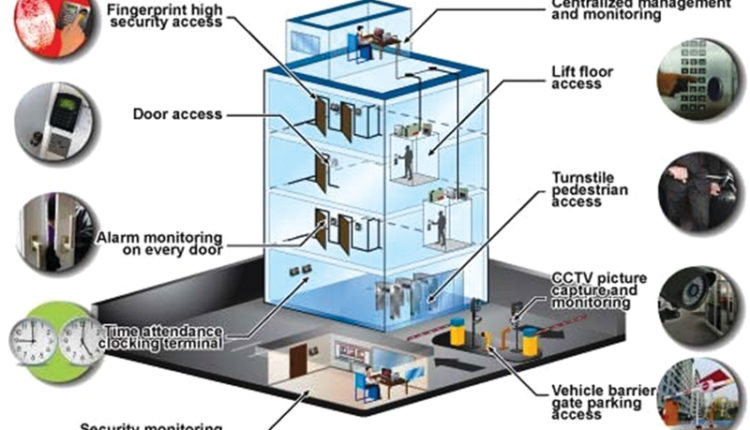Integrated access control solutions meet the Organizations security and business requirements. This helps to efficiently and reliably manage multiple access points, control risk, improve business efficiency, ensure business continuity and increase profitability.

Going beyond traditional access control creates new possibilities that help achieve compliance and best practice at all levels of the Organization.
An Integrated access control solution must make the following possible:
- Set door and zone entry rules
- Monitor all access points to know ‘where, when and why’ people are, at all times, on the premises.
- Proactively manage site access by integrating with existing HR systems to share information about clearances, credentials, inductions, required permits, licenses and other competencies for card holders
- Automatically enforce business health and safety policies and compliance with government regulations
- Welcome, manage and control access for visitors, ensuring that the Organizations duty of care and health and safety obligations are met
- Respond rapidly with a reliable and effective emergency management system, including lockdowns and alerts
- Control outputs such as lighting, heating, ventilation and air conditioning after-hours, with a smart system, that can manage facilities based on who is on site.
Manage intruder alarms with user defined handover to alarms monitoring stations.
Command Control software – is an integral part of any integrated access control solution.
This must be designed to help the Organization, easily and simply, manage access control at the site. The basic requirements of such a system would be as follows:
- Must be fully customizable to suit the unique needs of the site. It must allow the organization to configure, manage and report on all aspects of the system.
- Must allow seamless integration with other products. This will make it a powerful software platform that will make staff training easier and will improve business efficiency.
- Should be possible to provide access control both across single site facilities or multiple global sites.
- Manage cardholders, including their access, cards and photo identification.
- Monitor alarms and control all system aspects.
- Retrieve and report on stored system information.
- Interface to and exchange information with third party systems.
- Configure the site and all system components.
The system must have flexibility that allows for tailored solutions that address specific customer needs. Such flexibility helps Organizations achieve operational continuity, gain cost savings and generate revenue. They could also provide additional benefits such as the ability to meet compliance regulations and achieve workplace health and safety objectives.
Systems must operate on a common platform that gives the Organization the flexibility to select multi vendor hardware. Manufacturers are increasingly making their products operate on common systems platforms. What was once a technical nightmare of different protocols and technological incompatibility is increasingly becoming a “plug and play” solution, where the in-built technology manages all aspects of integration.
Leading security organisations are now placing emphasis on the access control system as the core integration platform. Instead of access control, intruder and CCTV systems working in near isolation from each other, they must be networked and centrally or remotely monitored and controlled via the access control solution. Easy integration starts with the CCTV camera systems linked into the graphical user interface of the access control software. This way, daily operations can be managed without having to switch between separate software systems. Practical examples of this include CCTV cameras that are programmed to pan to and automatically record specific events when activated by user defined triggers, such as a fire door being opened or a snap shot of the individual attempting an unauthorized access. The operator would immediately see live video from the appropriate camera pop-up on the screen and take action as required. This level of integration offers a greater level of supervisory capability to improve the overall efficiency and effectiveness of daily operations. Security officers can be better deployed, monitored and supported as they perform both routine site checks and specific incident response duties during out-of-hours periods such as overnight, weekends and bank holidays. Similarly, detector activations can lead to alarms being raised at a monitoring station located anywhere around the world.
Additional benefits of Integration
Work force management:
- Evacuation monitoring and providing visibility of staff and contractors in hazardous zones. Avoids lengthy delays when employees are to be cleared from unsafe areas.
- Employees feel safer, knowing that in an emergency they can be located promptly.
Enables the Organization to set up rules to govern the individual’s time on site in one shift, time on site across multiple shifts, and minimum break time between shifts. This helps in accurately managing employee fatigue levels. - Provide an alert if visitors have spent too long a period within a defined area.
Article by Kiron Kunte

Kiron Kunte has over 35 years of design and solutions experience, in Security, Telephony and Networking infrastructure. He is a graduate of IIT Bombay, a Fellow of the Institute of Engineers and has a post-graduate diploma, from Bombay University, in Systems Management. He is professionally certified in the design and engineering of Data Centres, IP Telephony, Video surveillance and Structured Cabling solutions. He heads Norik Konsult, a practice that offers advisory, design and system planning help to upgrade or build a new Telephony, Security and Networking infrastructure.
For more information contact:
www.norikkonsult.com

